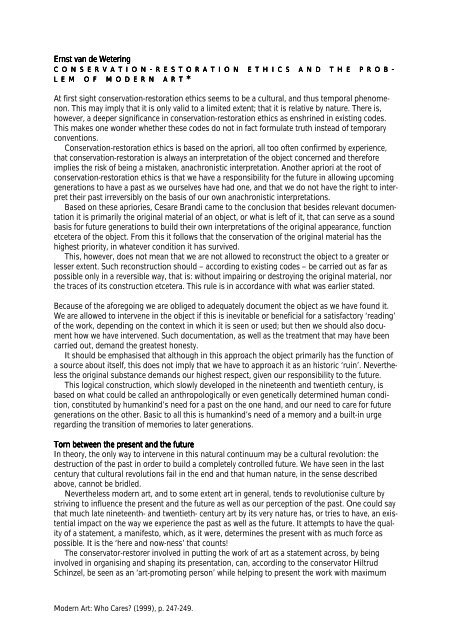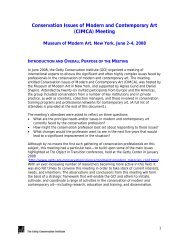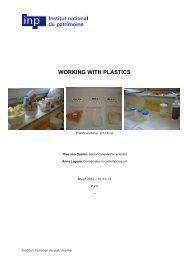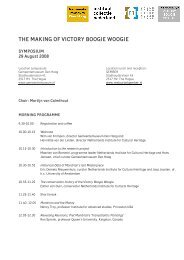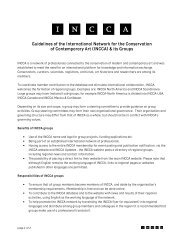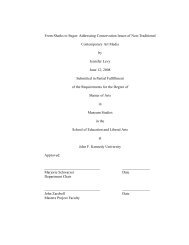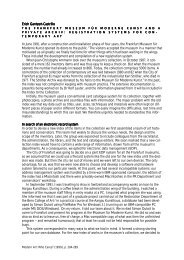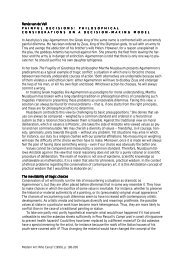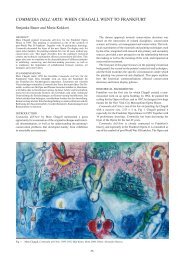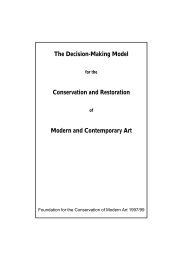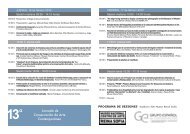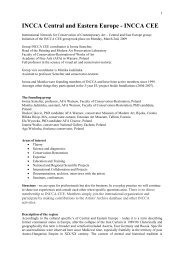VAN DE WETERING, E. Conservation-Restoration Ethics and ... - incca
VAN DE WETERING, E. Conservation-Restoration Ethics and ... - incca
VAN DE WETERING, E. Conservation-Restoration Ethics and ... - incca
You also want an ePaper? Increase the reach of your titles
YUMPU automatically turns print PDFs into web optimized ePapers that Google loves.
Ernst van de Wetering<br />
C O N S E R V A T I O N- N<br />
R E S T O R A T I O N E T H I C S A N D T H E P R O B-<br />
B<br />
L E M O F M O D E R N A R T* T<br />
At first sight conservation-restoration ethics seems to be a cultural, <strong>and</strong> thus temporal phenomenon.<br />
This may imply that it is only valid to a limited extent; that it is relative by nature. There is,<br />
however, a deeper significance in conservation-restoration ethics as enshrined in existing codes.<br />
This makes one wonder whether these codes do not in fact formulate truth instead of temporary<br />
conventions.<br />
<strong>Conservation</strong>-restoration ethics is based on the apriori, all too often confirmed by experience,<br />
that conservation-restoration is always an interpretation of the object concerned <strong>and</strong> therefore<br />
implies the risk of being a mistaken, anachronistic interpretation. Another apriori at the root of<br />
conservation-restoration ethics is that we have a responsibility for the future in allowing upcoming<br />
generations to have a past as we ourselves have had one, <strong>and</strong> that we do not have the right to interpret<br />
their past irreversibly on the basis of our own anachronistic interpretations.<br />
Based on these apriories, Cesare Br<strong>and</strong>i came to the conclusion that besides relevant documentation<br />
it is primarily the original material of an object, or what is left of it, that can serve as a sound<br />
basis for future generations to build their own interpretations of the original appearance, function<br />
etcetera of the object. From this it follows that the conservation of the original material has the<br />
highest priority, in whatever condition it has survived.<br />
This, however, does not mean that we are not allowed to reconstruct the object to a greater or<br />
lesser extent. Such reconstruction should – according to existing codes – be carried out as far as<br />
possible only in a reversible way, that is: without impairing or destroying the original material, nor<br />
the traces of its construction etcetera. This rule is in accordance with what was earlier stated.<br />
Because of the aforegoing we are obliged to adequately document the object as we have found it.<br />
We are allowed to intervene in the object if this is inevitable or beneficial for a satisfactory ‘reading’<br />
of the work, depending on the context in which it is seen or used; but then we should also document<br />
how we have intervened. Such documentation, as well as the treatment that may have been<br />
carried out, dem<strong>and</strong> the greatest honesty.<br />
It should be emphasised that although in this approach the object primarily has the function of<br />
a source about itself, this does not imply that we have to approach it as an historic ‘ruin’. Nevertheless<br />
the original substance dem<strong>and</strong>s our highest respect, given our responsibility to the future.<br />
This logical construction, which slowly developed in the nineteenth <strong>and</strong> twentieth century, is<br />
based on what could be called an anthropologically or even genetically determined human condition,<br />
constituted by humankind’s need for a past on the one h<strong>and</strong>, <strong>and</strong> our need to care for future<br />
generations on the other. Basic to all this is humankind’s need of a memory <strong>and</strong> a built-in urge<br />
regarding the transition of memories to later generations.<br />
Torn between the present <strong>and</strong> the future<br />
In theory, the only way to intervene in this natural continuum may be a cultural revolution: the<br />
destruction of the past in order to build a completely controlled future. We have seen in the last<br />
century that cultural revolutions fail in the end <strong>and</strong> that human nature, in the sense described<br />
above, cannot be bridled.<br />
Nevertheless modern art, <strong>and</strong> to some extent art in general, tends to revolutionise culture by<br />
striving to influence the present <strong>and</strong> the future as well as our perception of the past. One could say<br />
that much late nineteenth- <strong>and</strong> twentieth- century art by its very nature has, or tries to have, an existential<br />
impact on the way we experience the past as well as the future. It attempts to have the quality<br />
of a statement, a manifesto, which, as it were, determines the present with as much force as<br />
possible. It is the ‘here <strong>and</strong> now-ness’ that counts!<br />
The conservator-restorer involved in putting the work of art as a statement across, by being<br />
involved in organising <strong>and</strong> shaping its presentation, can, according to the conservator Hiltrud<br />
Schinzel, be seen as an ‘art-promoting person’ while helping to present the work with maximum<br />
Modern Art: Who Cares? (1999), p. 247-249.
impact. In that situation, the conservator-restorer deals primarily with the visual impact of the work<br />
according to the artist’s real or presumed wishes. He or she participates in a performance that is<br />
rather theatrical than museal in the traditional sense.<br />
But: the theatre is the place where lies create truth – interventions are taken which in the view of<br />
conservation-restoration ethics are heavyh<strong>and</strong>ed <strong>and</strong> highly unethical – radical repairs including<br />
complete reconstructions or, in the case of paintings, overpaintings. Such interventions may be<br />
carried out for the sake of the moment <strong>and</strong> may imply a serious loss of authenticity of the object as<br />
a source about itself <strong>and</strong> its maker.<br />
Thus in the field of contemporary art the conservator-restorer is torn between two forces: the<br />
existential power of the work as a statement in the present <strong>and</strong> his or her awareness that the object<br />
at some point, probably very soon, will be absorbed into the stream of time, becoming an historical<br />
object as well <strong>and</strong> deserving the utmost care as a source about its original appearance, own meaning<br />
<strong>and</strong> function for future generations.<br />
Differ<br />
ferent ent speeds of transfor<br />
forma<br />
mation<br />
Apart from the anthropological <strong>and</strong> restoration ethics anchored in a conservator-restorer’s role to<br />
preserve the past for the future, <strong>and</strong> the existential involvement of the artist to make a strong statement,<br />
there is thus a third aspect involved – the inevitability of the object’s transformation over<br />
time. This transformation does not only involve the ageing <strong>and</strong> changing of the material but especially<br />
takes place in the minds of the beholders. As to this last type of transformation, Br<strong>and</strong>i noted<br />
in his Teoria del Restauro that the object is constantly reborn in the minds of those who see it <strong>and</strong><br />
that it is undergoing a multitude of transformations in the process.<br />
For the conservator-restorer it is important to be aware of this phenomenon. To someone, for<br />
instance, who has known the artist or was once an assistant in his/her studio or helped in the presentation<br />
of the object, the speed of transformation is much slower than for the young conservatorrestorer<br />
of a later generation. The first category of conservators tends to prolong the present, in an<br />
effort to support the strength <strong>and</strong> actuality of the artist’s statement. For the young conservator, the<br />
same artist <strong>and</strong> the same object may be already history, with all the consequences this may entail<br />
for the care of the object as a source about the past <strong>and</strong> the sense of responsibility for its transition<br />
to the future. In this situation, the autonomy of conservation-restoration ethics already takes over<br />
for younger conservator-restorers while for older ones the present <strong>and</strong> the ‘theatrical’ function of<br />
the object prevails.<br />
The transformation of a work of art is tragic. Who would not like to prolong its ‘here <strong>and</strong> nowness’?<br />
No doubt, like other aspects of human life, the existential forces at first have priority over<br />
prudence <strong>and</strong> conservative forces. But, like in the existential situation of humankind, the transition<br />
of present into past is inevitable. And behind existential forces such as the lack of fear for risks, in a<br />
present situation there is also the natural inclination to care <strong>and</strong> the need to prolong life. It is then<br />
the classical ethics of conservation takes over even before the object’s existential power as part of<br />
the (prolonged) present has faded.<br />
Of course, given the transitoriness of many objects of contemporary art, the task to preserve<br />
is almost impossible. However, unless transitoriness is an integral <strong>and</strong> explicit part of the<br />
artist’s statement, one should not be resigned to these objects decaying, believing that a proper<br />
documentation would suffice to maintain the memory of an object. Documentation is always<br />
biased. One should rather stick to the adage that conservation-restoration does not mean doing the<br />
possible, but that it should mean doing the impossible. The classical ethics of restoration may then<br />
be the force behind the development of technical innovation which, as so often happened in the<br />
past, would make seemingly impossible acts of preservation possible.<br />
Ernst van de Wetering is professor of art history at the University of Amsterdam<br />
Modern Art: Who Cares? (1999), p. 247-249.
*The article has been published in: Hummelen, IJ., Sillé, D., Modern Art: Who Cares?, Amsterdam:<br />
Foundation for the <strong>Conservation</strong> of Modern Art/ Netherl<strong>and</strong>s Institute for Cultural Heritage, 1999,<br />
p. 247-249.<br />
Modern Art: Who Cares? (1999), p. 247-249.


